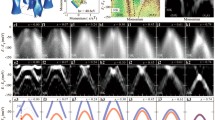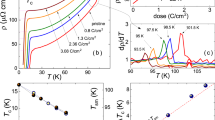Abstract
The Knight shift 207 K s for the 207Pb nuclei in the metal phase of the oxides BaPb1−x BixO3 (x < 0.35) has been analyzed as a function of the concentration. The shift, which is proportional to the density of states near the Fermi energy: 207 K s ∼ N(E F), reaches a maximum for an oxide with the maximum superconducting transition temperature T c(x ≈ 0.25) = 12 K. A significant increase in the width of the shift distribution with the Bi concentration testifies to the formation of a nonuniform state of the electronic system in the conduction band of superconducting oxides, which is accompanied by an increase in short-wavelength contributions to the spin susceptibility. To detect the 207Pb NMR spectra in superconducting oxides with x > 0.2, the 17O-207Pb spin-echo double-resonance method is used, which provides successful detection of the 207Pb NMR signal with an anomalously high rate of spin-spin relaxation T −12 > 500 ms−1. Thus, fundamental restrictions arising in investigations of rapidly relaxing 207Pb nuclei, which are “unobservable” in superconducting oxides BaPb1−x BixO3 when they are studied by traditional single-resonance methods of pulse NMR spectroscopy, have been overcome.
Similar content being viewed by others
References
A. W. Sleight, Solid State Commun. 17, 27 (1975).
B. Batlogg, Physica B (Amsterdam) 126, 275 (1984).
S. Ushida, Phase Transit. 8, 95 (1987).
T. Itoh, J. Phys. Soc. Jpn. 53, 2668 (1984).
H. Namatame, A. Fujimori, H. Takagi, et al., Phys. Rev. B 48, 16917 (1993).
H. Sakamoto, J. Phys. Soc. Jpn. 56, 365 (1987).
S. Tajima, S. Uchida, A. Masaki, et al., Phys. Rev. B 35, 696 (1987).
K. Machida, Physica C (Amsterdam) 156, 276 (1988).
T. M. Rice and L. Sneddon, Phys. Rev. Lett. 47, 689 (1981).
S. Uchida et al., Physica C (Amsterdam) 156, 157 (1988).
Yu. Piskunov, A. Gerashenko, A. Pogudin, et al., Phys. Rev. B 65, 134518 (2002).
T. Tsuda, J. Phys. Soc. Jpn. 56, 3032 (1988).
F. J. M. Benschop et al., Physica C (Amsterdam) 235–240, 2527 (1994).
E. Oldfield et al., Phys. Rev. B 41, 1289 (1990).
C. P. Slichter, Principles of Magnetic Resonance, 3rd ed. (Springer, New York, 1996).
A. V. Pogudin, V. V. Ogloblichev, Yu. V. Piskunov, et al., Pis’ma Zh. Éksp. Teor. Fiz. 80, 124 (2004) [JETP Lett. 80, 114 (2004)].
In oxides with x < 0.2 for the lead nuclei with 207 S = 1/2, the basic contribution to the rate T −12 of the irreversible damping of the echo signal comes from the indirect interaction 207 J ijSziSzj via the conduction electron system of the oxide with the constant 207 J ij ∼ 207 K. Except the oscillating character of the initial damping section, the amplitude of the echo signal decreases according to the exponential dependence M(2τ; ν) ∼ exp(−2τ/T 2(ν)), where the characteristic time of the transverse relaxation of the nuclear magnetization is T 2(ν) ∼ (207 K)−1.
K. Kumagai, Yu. Piskunov, A. Yakubovskii, et al., Physica C (Amsterdam) 274, 209 (1997).
A. M. Clogston, Phys. Rev. 136, A8 (1964).
T. D. Thanh, A. Koma, and S. Tanaka, Appl. Phys. A 22, 205 (1980).
Author information
Authors and Affiliations
Additional information
__________
Translated from Pis’ma v Zhurnal Éksperimental’no\(\overset{\lower0.5em\hbox{$\smash{\scriptscriptstyle\smile}$}}{l} \) i Teoretichesko\(\overset{\lower0.5em\hbox{$\smash{\scriptscriptstyle\smile}$}}{l} \) Fiziki, Vol. 82, No. 2, 2005, pp. 86–90.
Original Russian Text Copyright © 2005 by Ogloblichev, Pogudin, Piskunov, Verkhovski\(\overset{\lower0.5em\hbox{$\smash{\scriptscriptstyle\smile}$}}{l} \), Yakubovsky, Trokiner.




